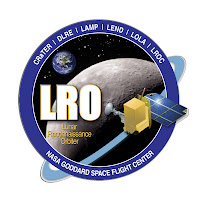NASA - Lunar Reconnaissance Orbiter (LRO) patch.
Dec. 9, 2011
Orbiting 31 miles above the lunar surface, NASA's Lunar Reconnaissance Orbiter (LRO) spacecraft will get a "front-row seat" to the total lunar eclipse on Dec. 10, 2011.
LRO's Diviner instrument will record how quickly targeted areas on the moon's day side cool off during the eclipse. The degree of cooling is dependent on factors such as how rocky the surface is, how densely packed the soil is, and its mineral composition. By studying the lunar surface during the eclipse, scientists can learn even more about our nearest celestial neighbor.
From beginning to end, the eclipse will last from 11:33 UT (6:33 a.m. EST, 3:33 a.m. PST) to 17:30 UT (12:30 p.m. EST, 9:30 a.m. PST). Totality, the time when Earth's shadow completely covers the moon, will last 51 minutes. All of the United States will see some portion of the eclipse. The West Coast will have a more complete view of this particular eclipse.
The West Coast will see totality as the moon sets and the sun rises. For West Coast viewers, the eclipse begins at 3:33 a.m. PST. The peak, when the moon is a deep red, occurs at 6:30 a.m. PST.
For East Coast residents, the only stage of the eclipse that will be visible is the earliest portion when the moon begins to enter Earth's shadow. This dimming is very slight and may be difficult to see.
A lunar eclipse occurs when Earth is directly between the sun and the moon, blocking the sun's rays and casting a shadow on the moon. As the moon moves deeper and deeper into Earth's shadow, the moon changes color before your very eyes, turning from gray to an orange or deep shade of red.
This 2003 image shows the ruddy appearance typical of the moon during a lunar eclipse. Credit: Fred Espenak.
The moon takes on this new color because sunlight is still able to pass through Earth's atmosphere and cast a glow on the moon. Our atmosphere filters out most of the blue colored light, leaving the red and orange hues that we see during a lunar eclipse. If there are additional dust particles in the atmosphere, the moon will appear to be a darker shade of red.
Unlike solar eclipses, lunar eclipses are perfectly safe to view without any special glasses or equipment. All you need is your own two eyes. Our next opportunity to view a total lunar eclipse from the U.S. is April 15, 2014, so mark your calendars!
For more information on lunar eclipses, visit http://www.nasa.gov/eclipse or http://eclipse.gsfc.nasa.gov/
Image (mentioned), Videos (mentioned), Text, Credit: NASA's Goddard Space Flight Center / Nancy Jones.
Greetings, Orbiter.ch

